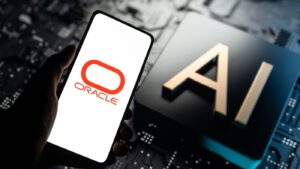- Jeff Lazarto
- Reading Time: 4 minutes

Artificial intelligence is driving the next great technology wave, and enterprises are racing to capture its value. While many cloud providers focus narrowly on GPUs or model-building, Oracle is shaping a broader vision: becoming the enterprise platform of choice for AI training, AI inferencing, and AI-native applications. Drawing from its latest earnings and commentary from Larry Ellison, Oracle’s strategy goes far beyond GPUs. It’s about redefining how enterprises unlock value from AI.
Oracle has presented a compelling AI value proposition but for customers to truly maximize value for the next decade and beyond, customers need to understand:
- Oracle’s AI vision and how it will influence product adoption and investment priorities
- Oracle’s motives and how to create leverage for negotiations
- What an optimized deal looks like and how to avoid being locked into subpar terms
In this article, we break down Oracle’s AI value proposition messaging to highlight what you can expect to hear from Oracle in upcoming renewals or net new sales pitches.
Building the World’s AI Infrastructure
At the foundation of Oracle’s AI push is Oracle Cloud Infrastructure (OCI). Oracle is building gigawatt-scale GPU superclusters optimized for AI training, capable of moving data faster than competitors. The logic is simple: if Oracle’s infrastructure trains models twice as fast, it effectively cuts the cost of training in half for customers. That value proposition has already attracted technology giants like OpenAI, xAI, Meta, NVIDIA, and AMD.
Customers should challenge and validate these claims for themselves, especially in the context of how a customer plans on utilizing OCI and AI.
The Real Prize: AI Inferencing
While AI training dominates headlines, Ellison made it clear that the true long-term opportunity is in AI inferencing, which will be the everyday use of trained models to run businesses, governments, and industries.
Think beyond model building: inferencing will eventually power autonomous factories, financial trading, medical diagnostics, legal automation, and sales optimization. Oracle believes this market will be much larger than training, and it is positioning its cloud and database technologies at the heart of it.
Customers should inquire about what this could mean specifically for their business and when Oracle thinks AI inferencing will become a reality.
The Oracle AI Database: Enterprise Data Meets LLMs
One of Oracle’s biggest differentiators is the AI Database, which can vectorize enterprise data, making it readable by AI models while keeping it secure. Customers can then connect their private data to leading large language models (LLMs) like ChatGPT, Gemini, Grok, and Llama, all available directly inside Oracle Cloud.
In theory, this will enable executives to ask questions like, “How will tariffs affect our next quarter’s revenue?” and get reasoned, data-driven answers without ever exposing sensitive information.
Customers should question how Oracle’s AI Database will keep their enterprise data more secure than other providers and how Oracle’s SLAs and contractual commitments reflect Oracle’s performance and security superiority claims.
AI-Native Applications: Software Written by AI
Oracle’s SaaS strategy is also undergoing a transformation. Instead of armies of developers writing applications by hand, Oracle is using AI application generators to create new products. These apps are essentially networks of AI agents, linked by workflow logic and embedded directly into ERP, HCM, and industry solutions.
Unlike rivals, Ellison stated that they are not charging separately for AI inside applications because the applications themselves are AI. Oracle’s goal is to deliver smarter, faster, AI-native applications that increase adoption and customer stickiness and increase revenue through greater adoption and volume.
Customers should request Oracle provide details into their product development roadmap as well as a written commitment from Oracle not to charge separately for AI capabilities.
Flexibility: Public, Multi-Cloud, and Private Cloud
Oracle’s multi-pronged cloud approach allows customers to run AI wherever they need to:
- Public Cloud: The standard Oracle Cloud Infrastructure (OCI) services delivered from Oracle’s global data centers. Customers share the infrastructure (multi-tenant), but tenants’ workloads are isolated securely.
- Multi-Cloud: Using Oracle Cloud services embedded inside other hyperscale clouds (AWS, Azure, Google Cloud).
- Private Cloud: Oracle cloud services delivered dedicated to a single customer, either on-premises or hosted. Think of it as a “private instance” of Oracle Cloud.
- The “Butterfly Cloud”: Oracle’s term for a hybrid cloud strategy that spans on-premises, Oracle Cloud, and other clouds. The “butterfly” symbolizes symmetry: one wing is OCI public cloud, the other is OCI Cloud@Customer (private), and the body connects to other clouds (multi-cloud).
Oracle’s AI Strategy Summed Up
Oracle’s AI strategy isn’t just about chasing today’s demand for GPUs. It’s about building a sustainable advantage at the intersection of infrastructure, data, and applications. By combining its strengths in cloud, database, and SaaS, Oracle is banking on becoming the enterprise standard for secure AI training and inferencing.
For enterprises, Oracle claims their AI strategy will deliver the following:
- Performance & Cost Efficiency – faster training, lower costs.
- Enterprise Data + AI Fusion – secure, contextual AI on private and public data.
- Flexibility – public, multi-cloud, and private deployment models.
- AI-Native Applications – ERP, HCM, and industry apps powered by AI agents that continuously learn and adapt.
- Future-Proofing – a path from today’s AI training to tomorrow’s inferencing-driven automation.
The Challenge for Customers
The challenge for customers choosing to move forward with Oracle AI will be in negotiating their deals. Whether it is OCI or Fusion, navigating the negotiation process with Oracle can be very challenging.
There are many issues to address depending on the scope of the agreement and whether it is a net new deal or a migration from perpetual licenses to cloud subscriptions. The good news is customers will have their highest negotiation leverage with Oracle. The key is knowing what a highly competitive deal looks like and how to navigate Oracle to obtain it. Customers that fail to negotiate the right deal could be saddled with a below market deal for many years, if not decades, so it is critical to get the initial deal right.
Additionally, Oracle just announced the promotions of Clay Magouyrk and Mike Sicilia as co-CEOs, with Safra Catz moving into the Executive Vice Chair role on Oracle’s board of directors. This succession plan has obviously been in the works for some time, but it will create pressure to continue to deliver on Oracle’s already impressive results and aggressive forecasts. Customers can use this to their advantage as part of an overall negotiation strategy.
Ready to unlock more value from your Oracle relationship? Our Oracle Commercial Advisory Services help enterprises negotiate smarter, optimize contracts, and align Oracle investments with business priorities. Learn how we can help.
Related Blogs
SAP Cloud ERP Packaging: Price Hikes Without Transparency
Inside SAP’s Q3 2025: Strong Cloud Growth, AI Push, and Pricing Power Plays
AI and the Future of Managed Services Contracts: Lessons from MSP Earnings Calls
About the Author
